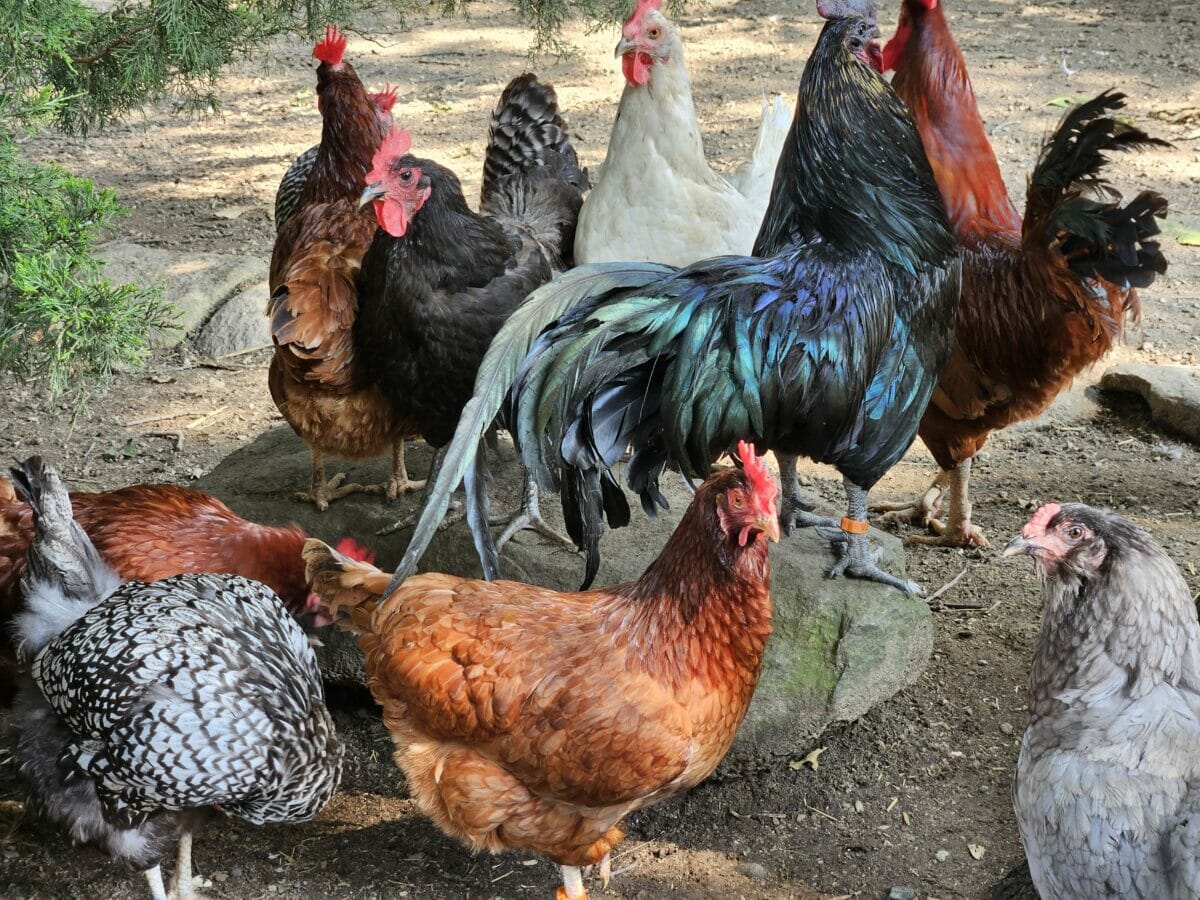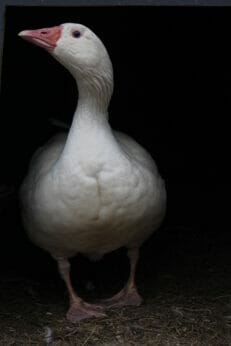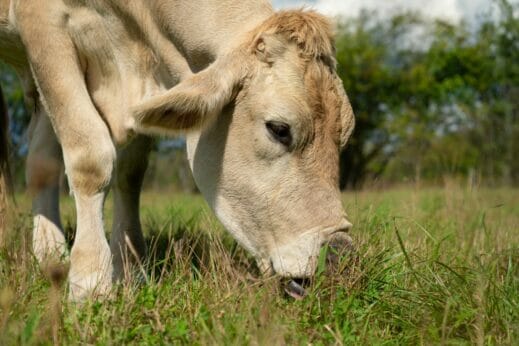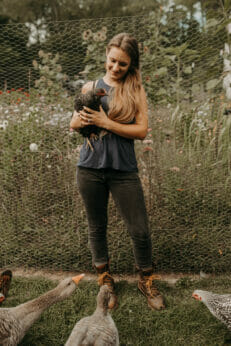A few months after backyard chickens became popular in the spring of 2020, farm rescues and sanctuaries saw an influx of surrendered birds. Now, they’re asking people to think twice before following their homesteading dreams.

When the lockdowns began at the start of the coronavirus pandemic, many people found themselves unexpectedly stuck at home. Some worried about the food supply chain, while others were simply bored. Staring out the window into their vacant backyards, people around the country were suddenly seized with the same inspiration.
Why not start a backyard homestead?
“At the beginning of the pandemic, the postal service worked,” says Kathy Halamka of the Unity Farm Sanctuary in Sherborn, MA. “That was the one thing that worked well. Chicks, goslings, poults and ducklings—all of these little guys can come in the mail, and that is a very regular way where the hatcheries send out their hatchlings.”

Mika, a rescue goose. Photography courtesy of Anika Wilson.
A duckling can be purchased for only a few dollars from a hatchery and provide entertainment for kids stuck at home. As a bonus, when the duck grows up, it produce fresh eggs. The idea was popular and soon hatcheries were selling out of chicks and ducklings. But as any poultry farmer knows, ducklings don’t stay small for long. Within two weeks, a baby duck will double both in size and in poop production. Long before you see any eggs from them, they will have outgrown your living room.
“We called it the time of the ducks,” says Halamka. Her sanctuary first noticed an increase in ducks and chickens—likely having outgrown their apartment homes and postage-stamp backyards—being surrendered to the sanctuary in the spring of 2020. Next came the roosters, surrendered as they began to find their voices. Finally, as people returned to work after the lockdown restrictions eased, entire flocks of poultry were given up to shelters. “We’ve never had that sort of broad surrender of hens,” says Halamka. “I would accept over a hundred hens at a time and have to find them new homes.”
Birds are the lowest cost option to begin homesteading. Ducklings, chicks and goslings are often for sale at feed stores in the springtime, and the thought that goes into their purchases can be the same as considering picking up a candy bar at the checkout. But the pandemic impulse purchases didn’t stop with poultry. Goats and sheep can be brought home for only a couple of hundred dollars—a purchase that might not require much forethought or consideration of feeding costs or vet bills.

Greg, a rescue steer. Photography courtesy of Anika Wilson.
Ashley Pankratz, senior manager of rescue & placement for Farm Sanctuary, an organization dedicated to advocating for farm animals, recalls a case of sheep and goats in Dutchess County, NY. The herd started with only a few animals, but,” Pankratz said in an email, “they quickly reproduced, and their guardian was unable to provide appropriate care. Soon, there were dozens of animals in need.”
Farm sanctuaries and rescues have long been places where people can turn when they have an unwanted rooster, but, since 2020, the number of animals in sanctuary care has increased significantly. The Farm Sanctuary, with locations in Watkins Glen, NY and Acton, CA, received 1,255 requests for placement in 2018. Now, it averages more than 1,500 requests a year.
Anika Wilson is a farmer and florist from outside Portland, ME, who was enlisted in the rehoming of more than 50 poultry from an island in Maine’s Casco Bay. The previous owner collected rare-breed birds, and she had amassed a large flock by the time she died in her 80s. “Luckily for these birds, they had a great caretaker on the island,” says Wilson. “I imagine that it would be a great challenge figuring out what to do with so many animals if you are not somewhat involved in the homestead world. It would be a lot to inherit.”
Wilson notes that the entire situation could have been avoided with forward planning. “In this case, a ‘death plan’ or ‘animal will’ that would provide for the animals would have been useful. In many cases, I think the most important thing is to really think before adopting creatures like this: ‘Am I prepared to care for this animal for x amount of years?’ and secondary to that, ‘Do I have options if I find, down the line, that circumstances change and I cannot care for them?’”

Anika Wilson.
Many people do not consider the longevity of animals when they take them on. Goats and sheep have an average lifespan of 10-15 years, while cows and pigs can live more than 20 years. Feed bills, veterinary care and infrastructure costs add up quickly. Livestock care can be physically demanding, making it difficult to keep up.
The most common animals surrendered to farm sanctuaries are poultry. Unwanted roosters from hatchery purchases make up the majority, and flocks from people who did not check their town’s ordinances on poultry are common. Sheep and goat purchases during the pandemic are more difficult to calculate, in part because goats and sheep are often paid for in cash from farm to individual, rather than sent via the postal service from a company with invoices and records.
Halamka says animals are often surrendered or rescued and end up at the Unity Farm Sanctuary because of caretaker deaths, home foreclosures and long-term illnesses. But there can be more abrupt cases, too.
“Sometimes, people literally move out of the apartment,” says Halamka, “and leave behind the mini pig or other animal. They literally walk away with the animal in the apartment. It’s very sad for me to have to work with animals that are found and have to be rescued.”
Planning can avoid these situations, as can a little bit of humility. Halamka is grateful that the majority of the animals she has seen since the pandemic are surrenders, and she notes that to surrender an animal you just have to call or email your local sanctuary
Following the pandemic uptick in livestock rescues, the hustle at sanctuaries has not slowed down thanks to inflation and foreclosures. Inflation has meant both that people’s budgets have been cut back, sometimes not leaving room for the livestock, and that people are again impulse purchasing poultry thinking they’ll get “free eggs.”
The conclusion seems simple. Animals should never be impulse purchases and require more planning than just a feed budget and proper housing. Ideally, if you are investing in animals, you should also make a plan in case something happens to you, so that the animals don’t end up at a sanctuary looking for a home.
If you’re going to homestead, you need to know how to cull your animals. They are livestock, not pets. If you raise chicks and turn out with a few roosters, have a plan for culling them (even smaller birds can be used to make stock). This idea of “finding homes” is just silly. Cull the birds and use their meat.
This is just ridiculous to me. Why wouldn’t you eat these animals? I don’t understand how they’re having a hard time finding homes for food…
“Free Eggs” I laugh every time I hear this. I tell people quite bluntly – that first egg will cost you somewhere between $1,000 and $2,000, depending on how thrifty you are, how good your carpentry skills are, how many predators live in your neighborhood, and how many NORMAL beginner mistakes you make. Backyard chicken farming is a hobby – one that I love and get so much daily enjoyment out of! – but those eggs are NOT free. And yes, roosters are yummy.
Both of my boys know what to do with the flock when I go toes up. They will be served at the funeral services. Along with anything in the garden that’s ready depending on what time of year I punch my ticket.
I recently downloaded a guide on commercial rabbit farming. It encouraged people new to farming rabbits to start small just to make sure it was right for them. It also devoted one section to point out that farming is hard work.
I believe that most animal abandonment can be explained by lack of understanding of the work involved and lack of caring for the animals.
Thank you for this thoughtful piece. I wish more publications would publicize this often overlooked, but terribly sad, aspect of the the backyard animal-farming trend.
I just take them in and butcher them for meat…
In TX..many are leaving in quantity the city for the country life & many are coming where never could have afforded land in other states..especially like milking goats are quickly bought up & there’s never enough poultry here.i ve given instructions to middle child <20 years>for inherenting the *flock of goats,chickens and 2 ducks,tx sized rabbits*.thank you for pointing it out for the rest that they need to realize that need a plan for their needs.ya’ll have a goatfull day!
When the pandemic started I saw line at the grocery store so I bought 100 Cornish rock to butch spent $30 a bird raised with organic ingredients we have a septic business an the people that work for us an anyone else I told if they had 5 people in there family the could have 5 chicken to butcher no one toke me up on it but if I butcher them they would take the birds what a bunch of pussy
It’s really just weakness farmers harvest we only keep the absolute best to breed again everything else is food and compost.